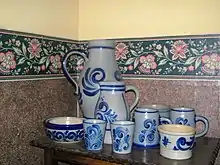
Westerwald pottery, or Westerwald stoneware, is a distinctive type of salt glazed grey pottery from the Höhr-Grenzhausen and Ransbach-Baumbach area of Westerwaldkreis in Rheinland-Pfalz, Germany. Typically, Westerwald pottery is decorated with cobalt blue painted designs, although some later examples are white. It may also be decorated with contrasting black or brown-purple designs.[1] The salt glaze creates a glossy surface.[2] It is also known as Kannenbäckerland stoneware.
History
Westerwald pottery originated from potting families from Siegburg and Raeren, in present-day Belgium, who emigrated to the Westerwald area in the 1580s and 1590s.[2] These immigrants included Anno Knütgen and his family, who traveled from Siegburg to Höhr, and the Mennicken family, who traveled from Raeren to Grenzhausen.[1]
By the 17th century, Westerwald stoneware became widely distributed throughout the world. The stoneware was often sent to British markets, sometimes with a molded medallion containing a portrait of William III of England inside a border with the king's name.[3] Others featured portraits of Louis XIV of France. Westerwald stoneware intended for the home market, rather than heraldry, often featured patterns of rosettes, lion's heads, cherubs, and stars.[4]
The Keramikmuseum Westerwald in Höhr-Grenzhausen displays the construction techniques and the history of salt glaze.[5]
References
- 1 2 "Westerwald stoneware". Encyclopedia Britannica. Retrieved 23 March 2023.
- 1 2 "Westerwald Stoneware". Historic Jamestowne. Retrieved 23 March 2023.
- ↑ Brain, Jeffrey. Tunica Treasure. Retrieved 23 March 2023.
- ↑ Hannover, Emil (1925). Europe and the Near East, earthenware and stoneware. Retrieved 23 March 2023.
- ↑ "Keramikmuseum Westerwald". Keramikmuseum.de. Retrieved 23 March 2023.
.